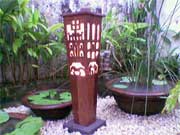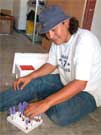By Elizabeth Pisani
825 words
20 July 1989
Reuters News
English
(c) 1989 Reuters Limited
KELIAN, Indonesia, July 20, Reuter - Five-year-olds equipped with tiny prospecting pans are among tens of thousands of Indonesians making a living digging and panning illegally for gold.
The success of the "illegals" is acknowledged in official figures. Licensed gold mines will produce only a fifth of the 21.6 tonnes of gold the government estimates will be exported this financial year, ending next March.
The government explains the discrepancy by saying the extra production comes from "traditional" miners, rice-growers who add to their incomes by panning for gold in the off-season.
It is less clear why more is not done to ensure the extra production is taxed. Some legitimate mining interests believe not all officials share the view that it is in the government's interest to increase legal output by firmer policing of unlicensed operations.
"If you were sitting back in a position of authority and got a bar of gold every now and then, you might not see it that way," commented one miner, who said the illegal miners work all the richest veins, leaving the multinationals to get at the gold that is more expensive to produce.
Industry sources say many of the illegal miners work for syndicates which smuggle production out of Indonesia.
"There's a very high level of organisation. The illegals in our area are financed by Chinese businessmen who make obvious payments to officials," said the manager of a mine in Kalimantan, the Indonesian part of Borneo.
He estimated that if smuggled gold were thrown into the export pot, the total figure could be as high as 30 tonnes. At present the government receives tax or royalty revenue from less than five tonnes.
Companies which hold mining rights to large tracts of gold-rich land in Indonesia's outlying islands say non-licensed miners, few of them locals, appear as soon as news of a multinational project leaks out.
One contractor said after news broke that his Canadian joint-venture firm had signed a prospecting contract, the number of illegal miners in the area ballooned from around 200 to some 10,000.
Contractors often tolerate illegals if they are only going for alluvial or surface gold that doesn't interest big operators. Some set aside specific areas where genuine traditional miners, local residents with simple hand-held equipment, can work.
Jakarta does recognise that illegals pose a threat to the legal mines whose gold production would help fill government coffers.
After the government had handed out more than 100 gold exploration contracts, President Suharto decreed that armed security forces be brought in to clear illegals from concession land if need be.
But contractors complain his decree has not always filtered through to regional officials who have to carry it out.
The deadline for the clearout was July 1988, but when a Reuters correspondent recently visited PT Kelian Equatorial Mining (KEM), an Australian joint-venture mine deep in the jungles of Kalimantan, there was no shortage of unauthorised gold seekers.
Young girls stood waist-deep in pits of water, expertly swirling pans of mud that would with luck yield gold, while men winched up buckets of earth from shafts.
They said on a good day they came away with around half a gram of gold each, worth about 4.50 dollars, or twice Indonesia's average daily wage.
"It's hard for me to send them away," said a policeman. "They are only doing it to fill their bellies."
By digging pits and using pumps to blast water at the riverbanks, filtering gold from the soil that washes off, illegal miners can do untold damage.
"It's criminal. Those guys are raping the riverbank," said Michele Hawke, senior geologist at KEM.
"No environmental impact studies for them. They just make one hell of a mess of things," said the manager of another mine.
In other areas the damage is more dangerous. One of the cheapest chemical ways to extract gold from ore is to mix it with the poisonous metal mercury.
"In our area, there are hundreds and hundreds of people all pumping sediments and mercury into the rivers and the sea. It's absolutely lethal," said a contractor from Sulawesi island.
Large mining companies use the more expensive cyanide, which decomposes soon after coming into contact with light and air.
Illegal miners with inadequate equipment run other risks, too. "Traditional miners aren't supposed to dig below 25 metres (80 feet). But some are down to 80 metres (262 feet), there are rockfalls constantly with 20 or 30 people killed," the mine manager said.
Their presence is not without its benefits to gold-rich areas.
"They come down like a swarm of locusts but they certainly support the local community. They have their bars and their brothels, they buy vegetables. Real frontier town stuff," said a miner with a concession in central Kalimantan.




